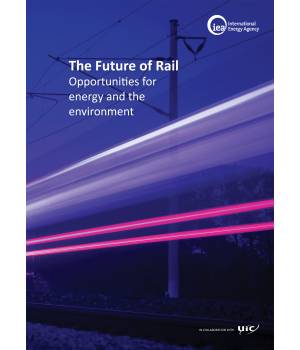
The Future of Rail
Rail has a long-standing position as one of the pillars of passenger mobility and freight transport. Today, conventional rail provides nearly one-sixth of the world’s long-distance passenger travel around and between cities. High-speed rail provides a high quality substitute to short-distance intracontinental flights. In cities, metros and light rail offer reliable, affordable and fast alternatives to road travel, reducing congestion and carbon dioxide (CO2) emissions and local pollution. Freight rail enables high capacity goods movements over very long distances, allowing access to trade for resources that otherwise would likely be stranded and facilitating operation of major industrial clusters.
Rail is among the most efficient and lowest emitting modes of transport. With a strong reliance on electricity, it is also the most energy diverse. Rail networks carry 8% of the world’s motorised passenger movements and 7% of freight transport, but account for only 2% of energy use in the transport sector. Rail services consume less than 0.6 million barrels per day (mb/d) of oil (about 0.6% of global oil use) and around 290 terawatt-hours (TWh) of electricity (more than 1% of global electricity use). They are responsible for about 0.3% of direct CO2 emissions from fossil fuel combustion and the same share (0.3%) of energy-related emissions of fine particulate matter (PM2.5). The high efficiency of train operations means that rail saves more oil than it consumes and more emissions than it generates. If all services currently performed by railways were carried by road vehicles, such as cars and trucks, then the world’s transport-related oil consumption would be 8 mb/d (15%) higher and transport-related greenhouse gas (GHG) emissions would increase by 1.2 gigatonnes (Gt) CO2-equivalent (CO2-eq) on a well-to-wheel basis.
Most rail networks today are located in India, the People’s Republic of China, Japan, Europe, North America and the Russian Federation, while metro and light rail networks operate in most of the world’s major cities. About 90% of global passenger movements on conventional rail take place in these countries and regions, with India leading at 39%, followed by the People’s Republic of China (“China”) (27%), Japan (11%) and the European Union (9%). Globally, about three-quarters of conventional passenger rail activity use electricity, and the remaining quarter relies on diesel. Significant investments have been made in high-speed rail and metros, most notably in China, which has overtaken all other countries in terms of network length of both types within a single decade. Today China accounts for about two-thirds of high-speed rail activity, having overtaken both Japan (17%) and the European Union (12%). The regional distribution of urban rail activity is more even; China, European Union and Japan each have around one-fifth of urban passenger rail activity. Both high-speed and urban rail are entirely powered by electricity. Freight movements are concentrated in China and the United States, each of which accounts for about one-quarter of global rail freight activity, and the Russian Federation (“Russia”), which accounts for one-fifth. Despite the fact that electrification of freight rail faces greater challenges than other rail types, half of global freight movements rely on electricity.
The future of rail will be determined by how it responds to both rising transport demand and rising pressure from competing transport modes. Rising incomes and populations in developing and emerging economies lead to strong demand for mobility, but social considerations and the need for speed and flexibility tend to favour car ownership and air travel. Rising incomes also drive demand growth in freight, where higher incomes, together with digital technologies, have sharply increased demand for rapid delivery of higher value and lighter goods. The rail sector has important advantages to exploit in competing for business, but this will require additional strategic investments in rail infrastructure, further efforts to improve its commercial competitiveness and technological innovation.
| Author | |
| ISBN | 978-2-7461-2818-7 |
| Pages | 175 |
Data sheet
- Language
- English
- Format
- Downloadable
- Edition
- Ed. no.1
- Edition date
- 01/01/2019
- Publication date
- 26/04/2019
- Page number
- 175
- Theme
- Freight Fret Passenger Voyageurs
- sku
- 5-19001E-PDF
- Paper size
- 21 x 29,7cm
- Reference
- 5-19001E
 Cookie preferences
Cookie preferences

